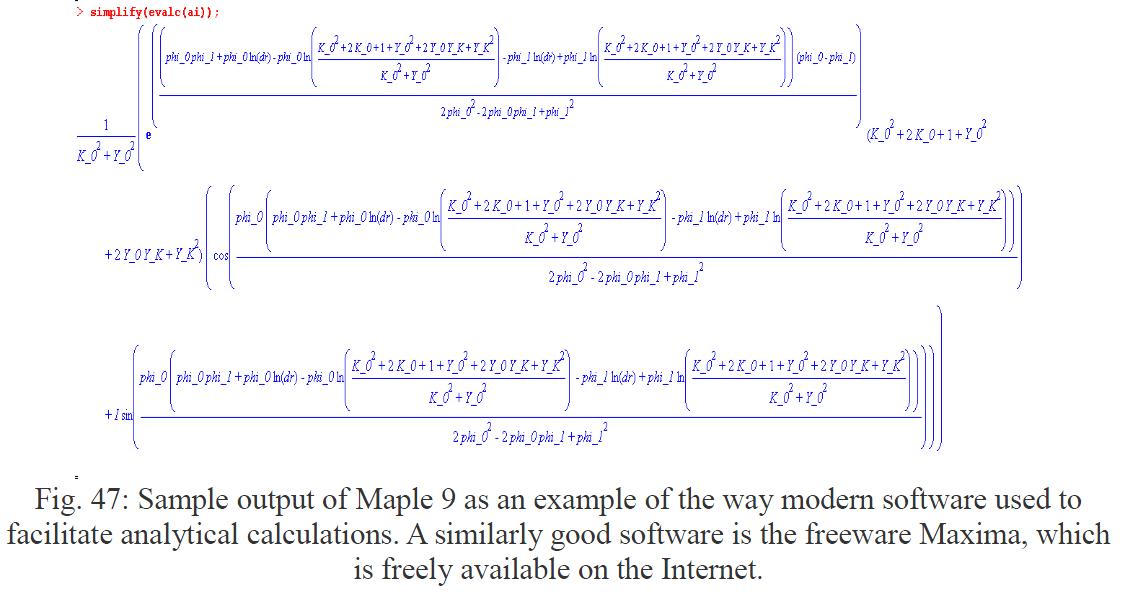47 Rotational-Stretching-Symmetry

If we want to transfer the position vector from
the Y-K-space currently used into the usual Y,K-t-space at the
time ![]() to the time
to the time ![]() , then we can
achieve this with the help of a rotational expansion. The rotational extension
symmetry is the same symmetry, as occurs in the multiplication of imaginary
numbers:
, then we can
achieve this with the help of a rotational expansion. The rotational extension
symmetry is the same symmetry, as occurs in the multiplication of imaginary
numbers:
![]() (47.1)
(47.1)
Our position vectors are as shown above, just
![]() and
and ![]() (47.2),
(47.2),
where we have set Y in the imaginary direction, ie in general
![]() (47.3)
(47.3)
for the position vector. The expression![]() is often
associated with the function
is often
associated with the function
![]() (47.4)
(47.4)
and abbreviated. It is now apparent manner:
![]() (47.5)
(47.5)
or
![]()
![]()
![]() (47.6)
(47.6)
with the implicit Logspiral-representation
![]() . The effect of
rotation and expansion is evidently composed of inflation or Pricing
. The effect of
rotation and expansion is evidently composed of inflation or Pricing![]() and trading gain
and trading gain![]() . How true that
is easily verified
. How true that
is easily verified
![]() (47.7)
(47.7)
and
![]() (47.8).
(47.8).
We see here already that![]() moves on its own axis of GDP, while
moves on its own axis of GDP, while![]() affects
the GDP and capital axis equally. Because inflation affects both the capital
and the value of GDP both measured in money. The implicit representation
affects
the GDP and capital axis equally. Because inflation affects both the capital
and the value of GDP both measured in money. The implicit representation
![]() results in
results in ![]() and
and
![]() .
.
Inserting brings:
![]() (47.9)
(47.9)
The effect of the helical symmetry is that now enters the commercial growth in the real and imaginary parts as well.
The dynamics of economic development thus corresponds allways to a rotation and expansion, so that a change in trade is always accompanied by a price change due.
The division of two complex numbers is given by![]() , and thus can88 be written:
, and thus can88 be written:
![]()
![]()
![]()
![]()
![]() (47.10)
(47.10)
Because of![]() and
and![]() at
at![]() it follows:
it follows:
![]() (47.11)
(47.11)
and ![]() (47.12)
(47.12)
This implicit representation we have to convert
into a suitable explicit time dependence. For![]() results in the
meantime:
results in the
meantime:
![]() (47.13)
(47.13)
and further to resolve complex for![]() takes after some
merging:
takes after some
merging:
![]() (47.14)
(47.14)
with the abbreviations:
![]() ,
,![]() ,
,![]() ,
,
![]() ,
,![]() ,
,![]() and
and ![]() (47.15).
(47.15).
And in accordance with this the inflation or price-formation is
![]() (47.16).
(47.16).

Then there is the transformation back to the usual time dimension. For this we assume the mathematical relationship
![]() (47.17)
(47.17)
The angular velocity![]() we can determine
by use of the start and end time of the model economics. Because the angle was
90 degrees =
we can determine
by use of the start and end time of the model economics. Because the angle was
90 degrees =![]() at the
beginning, and 0 at the end in our vector space of Y(K)-representation.
Therefore, one may write as we start counting at
at the
beginning, and 0 at the end in our vector space of Y(K)-representation.
Therefore, one may write as we start counting at![]() :
:
![]() und
und ![]() (47.18)
(47.18)
This is![]() the
time when the GDP dropped to zero in basis theory. With
the
time when the GDP dropped to zero in basis theory. With
![]() and
and ![]() (47.19)
(47.19)
one can now determine in principle the behavior of price formation and trading volume in the usual time dimension.